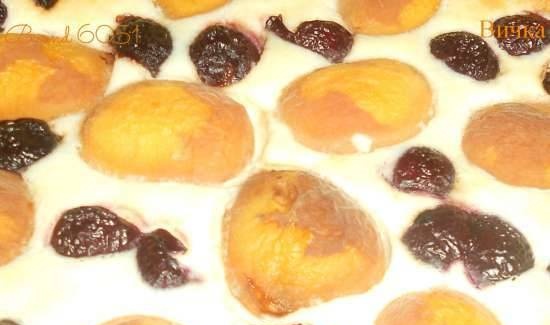|
Miranda
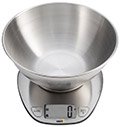
Kitchen scales are among the top 10 must-haves in the kitchen. It is as necessary as a good kitchen knife, whisk, cutting board, rolling pin, etc.
The stores offer a huge selection of kitchen scales of different sizes, shapes, additional options for every taste. Over the years of using various weights, I have come up with my own personal minimum weight requirements. And no compromises!
The latest scales were beautiful, but with one compromise. However, why there were, they still exist, and even work well, but after a while I noticed that I was staring at other scales in stores. And in the end, I bought myself another one.
My personal requirements for the scales:
1. Compact
2. A bowl, which can be a lid if turned over. If you have ever spilled or spilled anything, you will understand. Plus, in a small kitchen every bit of surface is important, and an inverted lid can be a surface too.
3. Auto power off in at least 2 minutes. Because you are weighing something, then something else, and for the third you need to go to the closet or to the balcony, came back, and the scales turned off.
4. Tare function, i.e. zeroing. Then you can weigh in any dish, just zeroing its weight.
5. No glasses - accidental sliding of the bowl / food on the glass is unpleasant for me
6. No mirrors - it's not for me to direct beauty, but to weigh the products, and I don't like random reflections, glare from the chandelier.
And finally, the same compromise that I made in the previous scales.
7. No flat platforms, the weighing platform must be raised above the scoreboard so that the scoreboard can be seen even under a wide plate.
All other features may or may not be.
***
For a very long time I had a Maxwell MW-1451 scale. Fly five or seven. And when they broke down, I wanted to buy exactly the same ones, but I fell for the beautiful, orange scales Oursson KS5006PD (will be compared)
But a year later, I still bought another one - Unit UBS-2153.
They looked promising, did not require any compromises, and were inexpensive.
Specifications:
The minimum weight is 1 g.
The maximum weight is 5kg.
Auto shutdown - 2 min. (But looking ahead, I will say that both without the bowl and with the bowl, after zeroing the container, the stopwatch showed the same time - 2 minutes 16 seconds.)
Power supply - 2 AAA batteries
The warranty is 2 years.
Service life - more than 10 thousand measurements
Made - China.
Designed - Austria.
Front box.

Sideways.

Above.

On the other hand, everything is the same, but in English.
Let's open the box. Simple but tightly packed.

Inside there are instructions, a 2-year warranty card, scales in a bowl.

Let's remove the bowl.
Between the bowl and the scales there is cardboard, the scales themselves are packed in two pimpled plastic bags.

Let's expand everything.
Stainless steel bowl, solid, very solid.
Bowl size - top diameter 21cm, bottom 11cm, height 9cm. Volume - exactly 2L entered. water, but it's on the very edge. And the instructions say - 0.8 liters. for some reason.
The size of the scales is 19.5 cm long, 18 cm wide in the widest part, and about 4.5 cm in the narrow one, where the display and buttons are 12 cm.

This is how the scale looks in profile.

And like that in the face.
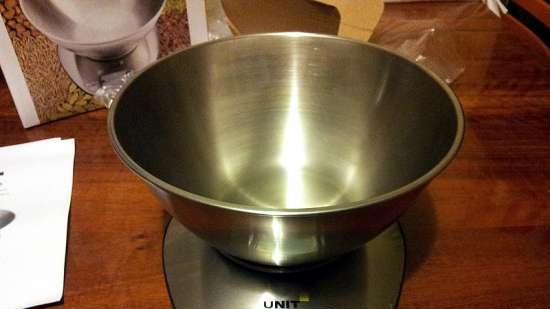
And this is how they look if you cover them with a bowl.
Oh, where is the scale?  Under the bowl! Under the bowl!
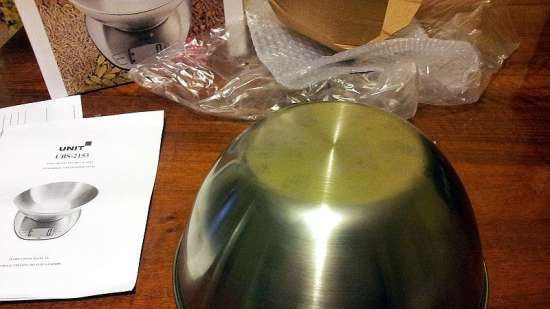
Below is a socket for batteries (AAA 2 pcs.) And a button (red arrow) for switching between the metric system of measurement (gr., Kg., Ml.) And the imperial system of measurement (lb, oz).
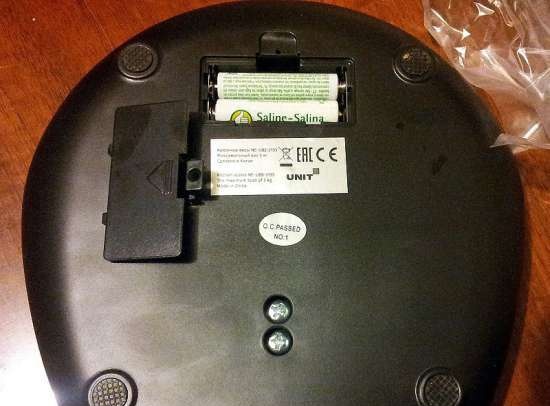
When enabled, all possible letters / numbers are displayed.
Switched on with the right ZERO button. (they turn on so quickly that I barely caught the moment for all the values to be on the display that I did not notice that the right button was in the shadow, but it would be visible in subsequent photos).
The scales have physical buttons, with a light click.
Left button - selection between g / kg, ml. water or ml. milk.
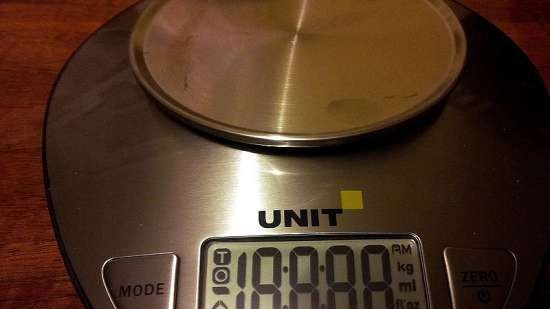
With grams / kilograms it is clear, but how to distinguish water from milk?
It's simple, this is how ml looks like. water
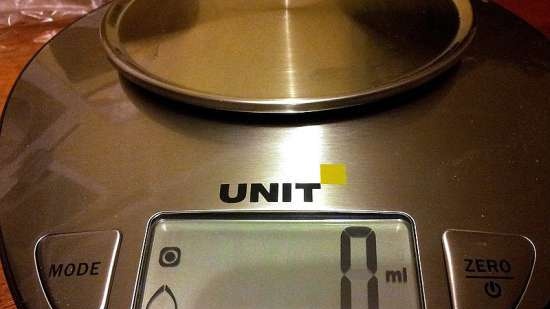
And so milk - with the letter M in the center.

Let's weigh something. Yes, even on different scales.
For example, a mold for creme brulee - a weight appears and g (grams)
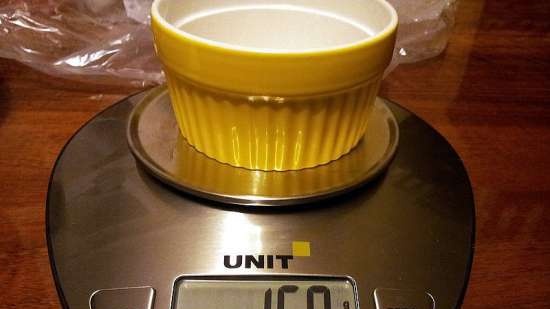
Other scales that will retire have the same weight.

And I also have a small scale, down to tenths for spices.
There is already more precise weight - 167.7g.
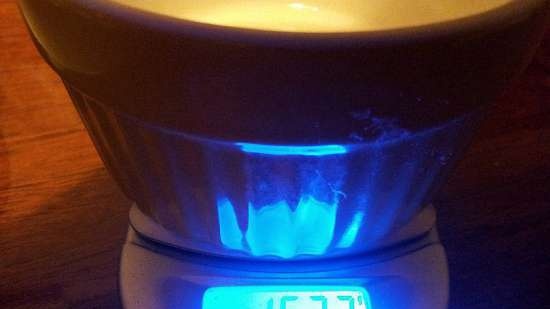
But because of what I decided to buy more scales.
On old ones, a simple plate covered the scoreboard.
Side and top view.

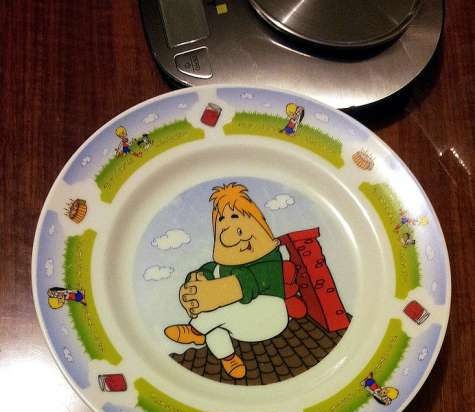
Let's see how things are on the new scales.
Also side and top view. Here you no longer have to bend too much to see the weight.


Let's weigh the milk.
Let's take about 200ml. Approximately, because although the measuring scale shows 200, there may be 198 or 202 ml.
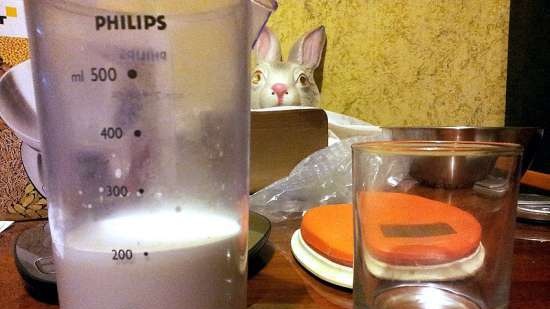
I zeroed the glass in advance on the new scales, now they are minus 221g. And on orange 199ml. milk. There is no weighing of milk, only water.
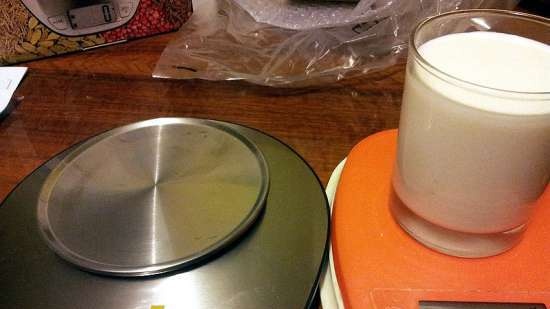
On a brand new scale, if weighed like water, then the same weight.
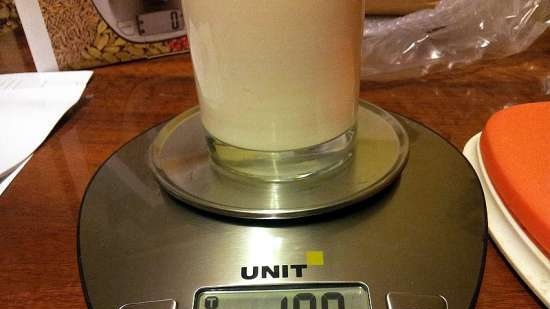
And if like milk - less, 193 ml.

Weigh the water.
This is a different glass, a little thinner. Zero it in advance on new scales. On old scales - 176ml.
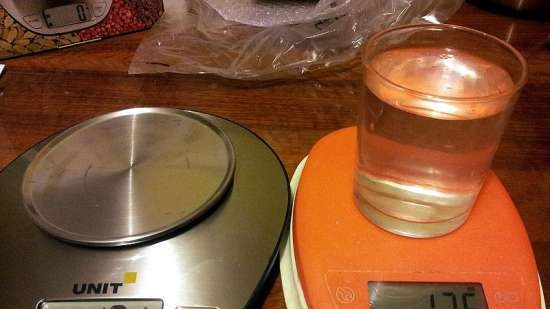
On new scales, it is also 176 ml, and on old scales, it shows a negative glass weight - 191.
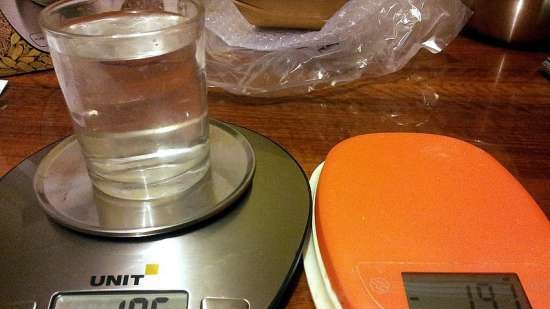
And if it weighs in grams?
Also 176.
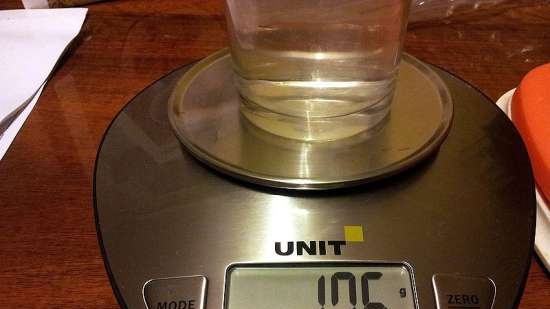
And if like milk?
Already smaller than 171ml.
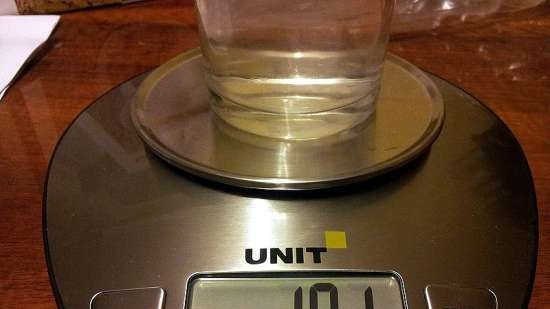
In fact, the presence of the function of weighing water is a certain craftiness of the manufacturers. The difference is only noticeable at high volumes. And even then, if the scales are moving from gr. in kg. show thousandths.
Because 1 liter of water = 998.5 g., And 3 liters of water - 2995 g. but the scale will show 2.99kg. Because the scales have a maximum weight of 5kg, then you can weigh 5 liters of water, but it will show not as 4992.5g, but as 4.99kg. Those. that as water weigh, as solid - the difference is equal to the error, and does not matter.
And it makes no sense at all on small volumes. After all, a glass of water is 250 ml. = 249.6 g., But the scales will round up to 250 g. If the recipe requires 50ml. or 100ml. water, it's all the same worth - ml. or gr. - will be the same number.
As for me, the function of weighing water is a fiction.
As for milk, there is already a mathematical calculation - an automatic calculator that calculates by the formula. Therefore, if you weigh plain water like milk, then the program inside will not understand this, and will count it as milk.
And by the way, the fatter the milk, the lighter.
According to GOST, 1 liter of skim milk (0.1% fat) is 1.030 kg, and 1 liter of high-fat milk (7.2% - 9.5% fat) is 1.024 kg. But, again, the difference between fat and low-fat milk is noticeable with large volumes, in a glass of 250 ml milk. this difference is insignificant - 1.5 g.
The calorie counting functions work the same way. There is a certain average value, for example, potatoes. But there may be young potatoes or last year's. Experts say that there is a different ratio of nutrients and calories. And if the variety is different?
Any calculations of what milk, what calories, and other things can be in the heaped up scales - this is all the averaged program inside the scales. Those. not real values, but approximate and average values.
Therefore, I believe that these are unnecessary functions, but only a way to sell the scales at a higher price. But milk is at least different from water. But if the scale has only one additional function for weighing water, then it is complete nonsense 
***
While I was going to write a review, I noticed an interesting feature. I even read the instructions that I usually don't do such simple things, because everything is clear anyway.
It turns out that if you press ZERO, zeroing the weight of something, you can go back and see how much it weighed by pressing ZERO again. Or use this feature for general summation.
For example, recall the weight.
I put the glass on the scales, the scales show 223 grams.
I reset it by pressing ZERO - 0 gr.
I forgot the weight - I press ZERO again - 223 gr.
Or, for example, what the summation looks like.
I put the glass on the scales, the scales show 223 grams.
I reset it by pressing ZERO - 0 gr.
I put a spoon in a glass - 33g.
I press ZERO - 256gr. (223 + 33)
I reset to zero again - 0 g.
I add another spoon - 33g.
ZERO again - 289g. (223 + 33 + 33).
I remove the second spoon - 256g.
I checked it on Oursson orange and on a small spice scale - there is no such thing. This is the first time I come across such an opportunity, while I have not yet understood whether I need it.
***
Total pluses:
one.I liked the bowl very much! Strong stainless steel, can be useful in the household and by itself.
2. Simple and understandable scales, all the necessary functions, nothing more.
3. Auto shutdown 2min.16sec.
4. The numbers on the board are large and well visible.
5. Batteries are common
Disadvantages:
Did not find.
If the platform was a little larger, I would not refuse.
For two weeks that I have been using the scales, no complaints.
It performs its functions well, comfortable, excellent bowl.
And the rest needs to be checked by time.
Good luck with your choice!
|




































